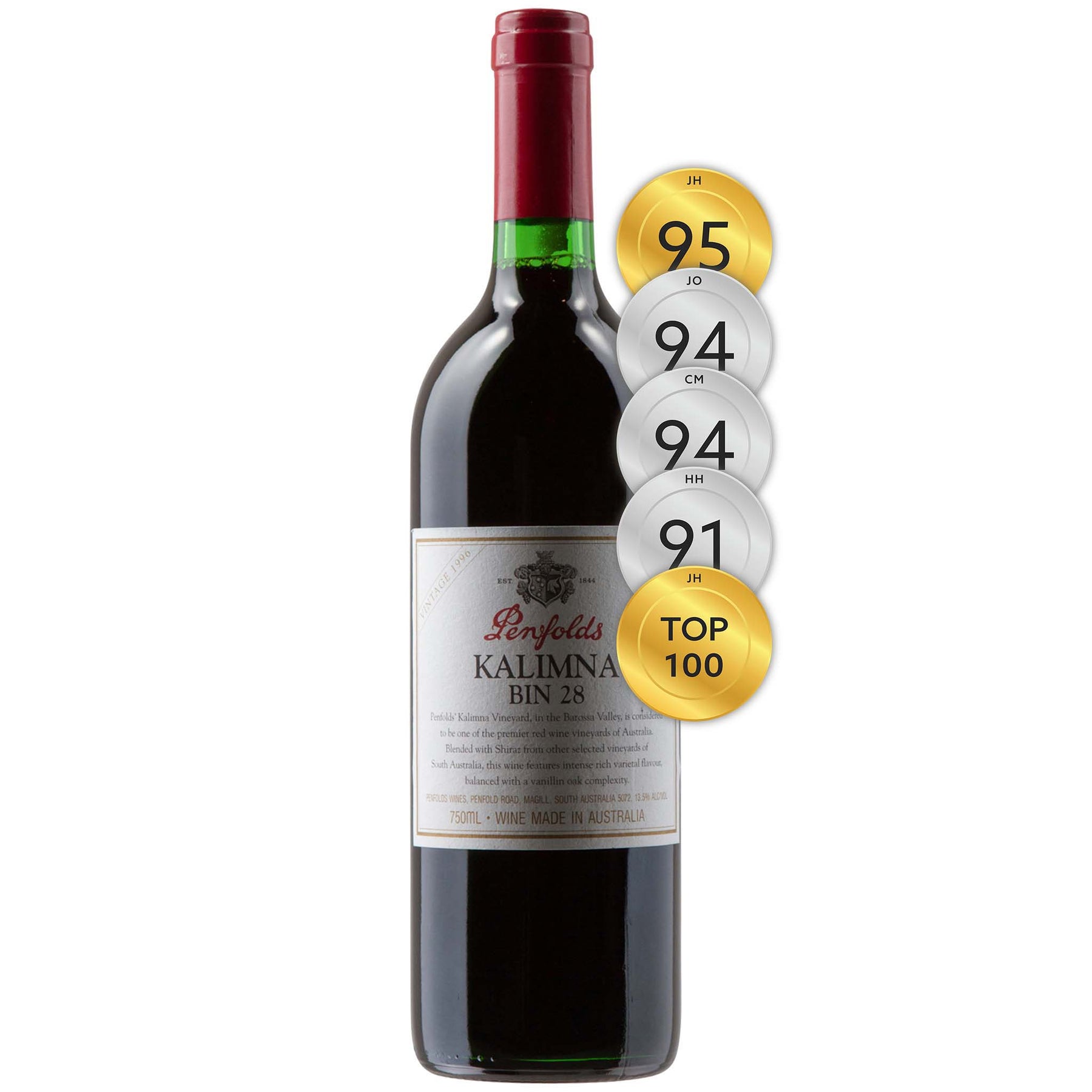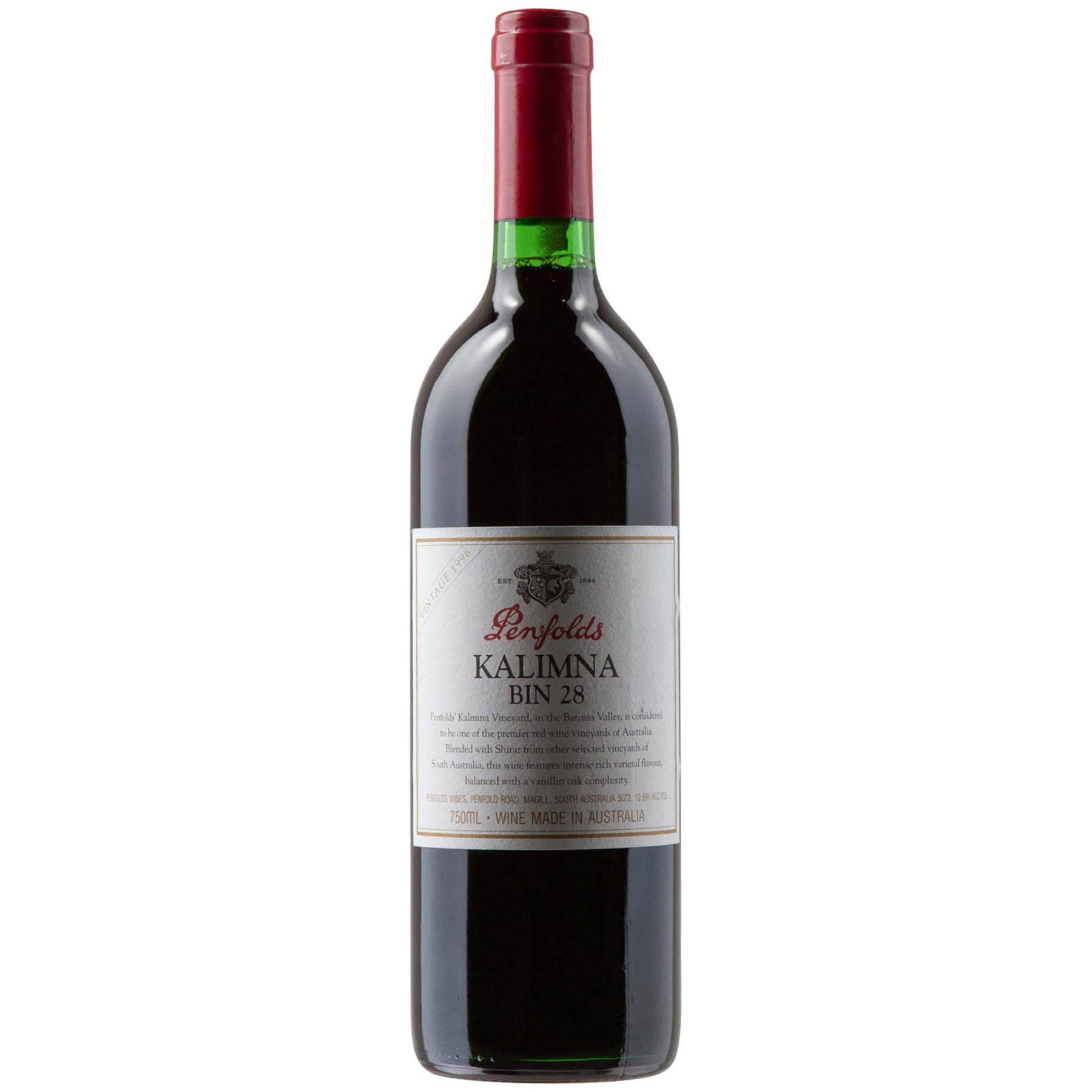

Penfolds Bin 28 Kalimna Shiraz 1996
Style: Red Wine
Variety: Shiraz
Closure: Cork
Penfolds Bin 28 Kalimna Shiraz 1996
Warehouse
34 Redland Drive
Vermont VIC 3133
Australia
Critic Score: 95
Alcohol: 13.5%
Size: 750 ml
Drink by: Now
James Halliday Top 100 Wines of 1999
Penfolds Bin 28 Kalimna Shiraz is the archetypal warm climate Australian shiraz - ripe, robust and generously flavoured. First made in 1959, Bin 28 is named after the famous Barossa Valley Kalimna vineyard purchased by Penfolds in 1945 and from which the wine was originally sourced. Today, Kalimna Bin 28 is a multi-region, multi-vineyard blend, with the Barossa Valley always well represented.
"A wine with an immaculate pedigree and from a great vintage, guaranteed to age slowly and gracefully. There are cascades of concentrated dark berry, liquorice and chocolate fruit on the bouquet; the super-smooth, fruit-driven palate is stacked with rich fruit and soft tannins woven throughout." James Halliday
The 1996 Bin 28 Kalimna was sourced from vineyards in Barossa Valley, McLaren Vale and Padthaway. The wine was matured for 12 months in new and used American oak.
"Medium deep red. Nose: Scented plum, blackberry, dark cherry, graphite, cedar aromas. Palate: A richly concentrated and gorgeously seductive wine with mocha, plum, graphite flavours, underlying spicy notes and supple tannins. Finishes firm with plenty of flavour length. A great Bin 28. Still has a good cellaring future." Penfolds Rewards of Patience, Sixth edition, 2008
"Vintage Conditions: 1996 was an outstanding year after the drought conditions of 1995. Much needed rains replenished the soils during the winter across most of South Australia. The first half of the growing season was dry and cool, allowing the fruit to set and mature slowly. The last two months of the season warmed to bring in physically mature, ripe complex fruit." Penfolds
Expert reviews
"A wine with an immaculate pedigree and from a great vintage, guaranteed to age slowly and gracefully. Deep purple-red, there are cascades of concentrated dark berry, liquorice and chocolate fruit on the bouquet; the super-smooth, fruit-driven palate is stacked with rich fruit and soft tannins woven throughout. Best drinking: 2001-2021." James Halliday, Halliday Wine Companion - 95 points and Top 100 Wines of 1999
"In gorgeous shape. Like the 1991, but with more meat. Will be the pick in years to come. Cedar, cherries, almonds. Lovely. Drink Now – 2021." Campbell Mattinson, The Wine Front - 94 points (Tasted Sep 2007)
Jeremy Oliver – 94 points
"Extra fruit power and elegance here, this is classy. Red and black fruits aroma; food driven and clean; robust and firm in mouth but starting to drink well. Very firm palate, tight and solid, has a way to go yet. Drink now to 15 years. 2nd bottle was similar, still youthful and emergent. Drink: 2011-2025." Huon Hooke, The Real Review - 91 points (Tasted Sep 2007)
Awards
James Halliday's Top 100 Wines of 1999
About the winery
After the success of early sherries and fortified wines, founders Dr Christopher and Mary Penfold planted the vine cuttings they had carried on their voyage over to Australia. In 1844 the fledging vineyard was officially established as the Penfolds wine company at Magill Estate.
As the company grew, so too did Dr Penfold's medical reputation, leaving much of the running of the winery to Mary Penfold. Early forays into Clarets and Rieslings proved increasingly popular, and on Christopher's death in 1870, Mary assumed total responsibility for the winery. Mary's reign at the helm of Penfolds saw years of determination and endeavour.
By the time Mary Penfold retired in 1884 (ceding management to her daughter, Georgina) Penfolds was producing 1/3 of all South Australia's wine. She'd set an agenda that continues today, experimenting with new methods in wine production. By Mary's death in 1896, the Penfolds legacy was well on its way to fruition. By 1907, Penfolds had become South Australia's largest winery.
In 1948, history was made again as Max Schubert became the company's first Chief Winemaker. A loyal company man and true innovator, Schubert would propel Penfolds onto the global stage with his experimentation of long-lasting wines - the creation of Penfolds Grange in the 1950s.
In 1959 (while Schubert was perfecting his Grange experiment in secret), the tradition of 'bin wines' began. The first, a Shiraz wine with the grapes of the company's own Barossa Valley vineyards was simply named after the storage area of the cellars where it is aged. And so Kalimna Bin 28 becomes the first official Penfolds Bin number wine.
In 1960, the Penfolds board instructed Max Schubert to officially re-start production on Grange. His determination and the quality of the aged wine had won them over.
Soon, the medals began flowing and Grange quickly became one of the most revered wines around the world. In 1988 Schubert was named Decanter Magazine's Man of the Year, and on the 50th anniversary of its birth, Penfolds Grange was given a heritage listing in South Australia.
Despite great success, Penfolds never rests on its laurels. In 2012 Penfolds released its most innovative project to date - 12 handcrafted ampoules of the rare 2004 Kalimna Block Cabernet Sauvignon.
Two years later, Penfolds celebrated the 170th anniversary – having just picked up a perfect score of 100 for the 2008 Grange in two of the world's most influential wine magazines. Today, Penfolds continues to hold dear the philosophies and legends – '1844 to evermore!'.

South Australia
South Australian is responsible for more than half the production of all Australian wine. It is home to more than 900 wineries across 18 wine regions. The regions are Adelaide Hills, Adelaide Plains, Barossa Valley, Clare Valley, Coonawarra, Currency Creek, Eden Valley, Kangaroo Island, Langhorne Creek, McLaren Vale, Mount Benson, Mount Gambier, Padthaway, Riverland, Robe, Southern Fleurieu, Southern Flinders Ranges and Wrattonbully.
Many of the well-known names in the South Australian wine industry established their first vineyards in the late 1830s and early 1840s. The first vines in McLaren Vale were planted at Reynella in 1839 and Penfold's established Magill Estate on the outskirts of Adelaide in 1844.
South Australia has a vast diversity in geography and climate which allows the State to be able to produce a range of grape varieties - from cool climate Riesling in the Clare and Eden Vallies to the big, full bodied Shiraz wines of the Barossa Valley and McLaren Vale. Two of Australia's best-known wines, Penfolds Grange and Henschke Hill of Grace, are produced here. There is much to discover in South Australia for the wine lover.

